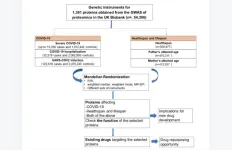(Press-News.org) **ECCMID has now changed its name to ESCMID Global, please credit ESCMID Global Congress (formerly ECCMID, Barcelona, Spain, 27-30 April) in all future stories**
Experts are working on a new type of ultraviolet light called far-UVC that could be highly effective for reducing air-borne transmission of diseases such as COVID-19 and influenza, as well as surface contamination in hospitals, with hopes that it could even reduce the risk of the next pandemic.
In a new research review presented at this year’s ESCMID Global Congress (formerly ECCMID) in Barcelona, Spain (27-30 April), Dr Curtis Donskey from the Louis Stokes Cleveland VA Medical Center in Cleveland, Ohio, USA, will discuss the efforts being made to develop this continuous surface and air decontamination technology in clinical settings and the safety concerns that still need to be addressed.
In the face of a persistent global pandemic, disinfectants are more important than ever. Airborne transmission of diseases such as COVID-19 and tuberculosis in public spaces has highlighted a clear need for improved technologies to limit their spread. Similarly, environmental contamination plays a key role in the spread of healthcare-associated infections, with pathogens such as Methicillin-resistant Staphylococcus aureus (MRSA) and Clostridioides difficile able to persist on surfaces, contributing to the spread of infections. More than 3.5 million healthcare-associated infections occur in the European Union and European Economic Area (EU/EEA) every year, leading to over 90,000 deaths [1].
“Compounding the problem, and a major limitation of traditional cleaning and disinfection strategies, is that disinfected surfaces rapidly become re-contaminated between manual cleaning episodes”, explains Dr Donskey. “Daily cleaning of patient rooms is likely to be inadequate to reduce the burden of infectious pathogens, and manual cleaning of intricate surfaces, equipment, and devices makes thorough cleaning difficult. These limitations have led to the development of technologies that can provide continuous decontamination of occupied spaces between episodes of manual cleaning. The holy grail is a technology that is effective against surface and airborne pathogens and is automated, safe, and reasonably priced.”
One of the most promising candidates are ultraviolet light technologies. “It's been known since the 1940s that ultraviolet light can kill bacteria and inactivate viruses in the air so that they are no longer infectious”, says Dr Donskey. “Conventional UV light has been used widely in hospitals and prisons, but it can damage the skin and eyes, so it can only be used when a room is empty. Because re-contamination of rooms and surfaces is so quick, the goal has been to continuously decontaminate rooms with people in them.”
Far UV-C has a shorter wavelength (222 nm) than conventional germicidal UVC light (254 nm) and cannot penetrate or harm skin, eyes or tissue. Studies have shown that far-UVC light can kill the SARS-CoV-2 virus, other human coronaviruses, influenza, and drug-resistant bacteria quickly and efficiently [2]. And because of the way ultraviolet light kills microbes, viruses, and bacteria, they cannot develop resistance as they do with vaccines and drug treatments. Additional tests in real-room environments have found that far UV-C reduced infectious airborne viruses by over 99%—much greater than is generally achieved using typical air filtration and ventilation [3].
“Several studies have suggested that far UV-C light at the current regulatory limit may be safe for use around people, but more studies are needed to confirm the safety of these rays in clinical settings and with longer-term follow-up before it is likely that they will be routinely used in occupied healthcare settings,” cautions Dr Donskey. “It is also vital that we assess ozone concentrations because far UV-C technologies have the potential to generate modest amounts of ozone.” Based on the information currently available, the US Centers for Disease Control and Prevention has stated that in the near-term whole-room UV is best viewed as new and emerging technology.
Nevertheless, far UV-C (222 nm) has emerged as a leading continuous decontamination technology with several commercial technologies currently being marketed. A few of the companies marketing far UV-C devices include Ushio (Care222 Filtered Far UV-C Excimer Lamp Module), Sterilray (GermBuster Channel), Lit Thinking (Visium), and Far UV Technologies. “Some early adopters have begun using these technologies in healthcare settings,” says Dr Donskey. “For example, a dental office in Ohio installed far UV-C lamps in 5 patient treatment rooms in 2020 and has operated the technology for thousands of hours with no reports of adverse effects. Partnering with such early adopters could be useful to acquire information on long-term safety of far UV-C.”
He adds, “One novel approach that could accelerate earlier implementation of far UV-C in clinical settings would be its intermittent rather than continuous delivery. Such an approach would only deliver far UV-C when a room is empty and turns off when people are present. We are currently evaluating this intermittent approach for decontamination of equipment rooms, bathrooms, sinks, and patient rooms. We anticipate that hospitals will be more willing to consider use of the technology in clinical areas using this approach while additional safety data is being generated.”
END
New ultraviolet light air disinfection technology could help protect against healthcare infections and even the next pandemic
Low doses of a particular wavelength of ultraviolet light, known as far-UVC, can kill viruses and bacteria without the safety concerns of conventional ultraviolet light.
2024-04-25
ELSE PRESS RELEASES FROM THIS DATE:
Major genetic meta-analysis reveals how antibiotic resistance in babies varies according to mode of birth, prematurity, and where they live
2024-04-25
Meta-analysis of genetic studies from 10 countries finds infants born by C-section have more antibiotic resistance genes; antibiotic use and prematurity also fuel resistance.
Infants living in Africa had more antibiotic resistant genes than those from Europe.
Findings indicate that interventions targeting the gut microbiome of mothers and their infants, such as probiotics, could help reduce antibiotic resistance spread.
**ECCMID has now changed name to ESCMID Global, please credit ESCMID Global Congress in all future stories**
A meta-analysis of genetic studies analysing the microbiota (bacteria in the gut) of 1,275 infants from 10 countries finds that caesarean delivery and antibiotic ...
Q&A: How TikTok’s ‘black box’ algorithm and design shape user behavior
2024-04-24
TikTok’s swift ascension to the upper echelons of social media is often attributed to its recommendation algorithm, which predicts viewer preferences so acutely it’s spawned a maxim: “The TikTok algorithm knows me better than I know myself.” The platform’s success was so pronounced it’s seemed to spur other social media platforms to shift their designs. When users scroll through X or Instagram, they now see more recommended posts from accounts they don’t follow.
Yet for all that influence, the public knows little about how TikTok’s ...
American Academy of Arts and Sciences elects three NYU faculty as 2024 fellows
2024-04-24
The American Academy of Arts and Sciences has elected three New York University faculty as 2024 fellows: Glennys R. Farrar, a professor in the Department of Physics; André A. Fenton, a professor and chair of the Center for Neural Science; and Rachel L. Swarns, a professor in the Arthur L. Carter Journalism Institute.
“We honor these artists, scholars, scientists, and leaders in the public, non-profit, and private sectors for their accomplishments and for the curiosity, creativity, and courage required ...
A closed-loop drug-delivery system could improve chemotherapy
2024-04-24
When cancer patients undergo chemotherapy, the dose of most drugs is calculated based on the patient’s body surface area. This is estimated by plugging the patient’s height and weight into an equation, dating to 1916, that was formulated from data on just nine patients.
This simplistic dosing doesn’t take into account other factors and can lead to patients receiving either too much or too little of a drug. As a result, some patients likely experience avoidable toxicity or insufficient benefit from the chemotherapy they receive.
To make chemotherapy dosing more ...
MIT scientists tune the entanglement structure in an array of qubits
2024-04-24
Entanglement is a form of correlation between quantum objects, such as particles at the atomic scale. This uniquely quantum phenomenon cannot be explained by the laws of classical physics, yet it is one of the properties that explains the macroscopic behavior of quantum systems.
Because entanglement is central to the way quantum systems work, understanding it better could give scientists a deeper sense of how information is stored and processed efficiently in such systems.
Qubits, or quantum bits, are the building blocks of a quantum computer. However, it is extremely difficult to make specific entangled states in many-qubit ...
Geologists discover rocks with the oldest evidence yet of Earth’s magnetic field
2024-04-24
Geologists at MIT and Oxford University have uncovered ancient rocks in Greenland that bear the oldest remnants of Earth’s early magnetic field.
The rocks appear to be exceptionally pristine, having preserved their properties for billions of years. The researchers determined that the rocks are about 3.7 billion years old and retain signatures of a magnetic field with a strength of at least 15 microtesla. The ancient field is similar in magnitude to the Earth’s magnetic field today.
The open-access findings, appearing ...
It’s easier now to treat opioid addiction with medication -- but use has changed little
2024-04-24
For years, even as opioid overdose deaths dramatically increased, doctors and other prescribers in the United States needed special permission from the federal government if they wanted to prescribe buprenorphine, a medication that helps patients overcome opioid addiction and prevents fatal overdoses.
That requirement, called an “X waiver”, was eliminated on January 12, 2023 due to an item in a major federal budget bill. This meant that suddenly, any clinician who had a license to prescribe controlled substances could prescribe ...
Researchers publish final results of key clinical trial for gene therapy for sickle cell disease
2024-04-24
Philadelphia, April 24, 2024 – In a landmark study, an international consortium led by researchers at Children’s Hospital of Philadelphia (CHOP) published the final results of a key clinical trial of the gene therapy CASGEVY (exagamglogene autotemcel) for the treatment of sickle cell disease in patients 12 years and older with recurrent vaso-occlusive crises (VOCs). The study found that 96.7% of patients in the study did not have any vaso-occlusive crises (VOCs) – a blockage that results in lack of oxygen and painful episodes – for at least one year, and 100% were able to remain hospitalization-free for the same ...
Identifying proteins causally related to COVID-19, healthspan and lifespan
2024-04-24
“[...] we identified multiple proteins affecting COVID-19 and aging.”
BUFFALO, NY- April 24, 2024 – A new research paper was published in Aging (listed by MEDLINE/PubMed as "Aging (Albany NY)" and "Aging-US" by Web of Science) Volume 16, Issue 7, entitled, “Using genetics and proteomics data to identify proteins causally related to COVID-19, healthspan and lifespan: a Mendelian randomization study.”
The COVID-19 pandemic poses a heavy burden on public health and accounts for substantial mortality and morbidity. Proteins are building blocks of life, but specific proteins causally related ...
New study reveals how AI can enhance flexibility, efficiency for customer service centers
2024-04-24
BINGHAMTON, N.Y. -- Whenever you call a customer service contact center, the team on the other end of the line typically has three goals: to reduce their response time, solve your problem and do it within the shortest service time possible.
However, resolving your problem might entail a significant time investment, potentially clashing with an overarching business objective to keep service duration to a minimum. These conflicting priorities can be commonplace for customer service contact centers, which often rely on the latest technology to meet customers’ ...
LAST 30 PRESS RELEASES:
Scientists ID potential way to prevent brain injuries from triggering Alzheimer's
MASTER 2nd Open Call: Execution period kick-off
Algae for health in food and pharma
Advanced microrobots driven by acoustic and magnetic fields for biomedical applications
Chicago health information leader recognized for raising CPR readiness and blood pressure awareness
The Intimate Animal, a new book from Kinsey Institute Executive Director Dr. Justin Garcia
When blue-collar workers lose union protection, they try self-employment
New video dataset to advance AI for health care
MEA-based graph deviation network for early autism syndrome signatures in human forebrain organoids
New modeling approach sheds light on rare gut disease
Study documents potentially hazardous flame retardants in firefighter gear
Can certain bacteria regulate aging of the immune system and its related alterations?
AI model helps diagnose often undetected heart disease from simple EKG
There are fewer online trolls than people think
Cell membrane fluctuations produce electricity
Jeonbuk National University study shows positive parenting can protect adolescents against self-harm
Surface-engineered ZnO nanocrystals to tackle perfluoroalkyl substance contamination
This new understanding of T cell receptors may improve cancer immunotherapies
A new fossil face sheds light on early migrations of ancient human ancestor
A new immunotherapy approach could work for many types of cancer
A new way to diagnose deadly lung infections and save lives
40 percent of MRI signals do not correspond to actual brain activity
How brain-inspired algorithms could drive down AI energy costs
Gum disease may be linked to plaque buildup in arteries, higher risk of major CVD events
Contrails are a major driver of aviation’s climate impact
Structure of dopamine-releasing neurons relates to the type of circuits they form for smell-processing
Reducing social isolation protects the brain in later life
Keeping the heart healthy increases longevity even after cancer
Young adults commonly mix cannabis with nicotine and tobacco
Comprehensive review illuminates tau protein's dual nature in brain health, disease, and emerging psychiatric connections
[Press-News.org] New ultraviolet light air disinfection technology could help protect against healthcare infections and even the next pandemicLow doses of a particular wavelength of ultraviolet light, known as far-UVC, can kill viruses and bacteria without the safety concerns of conventional ultraviolet light.


